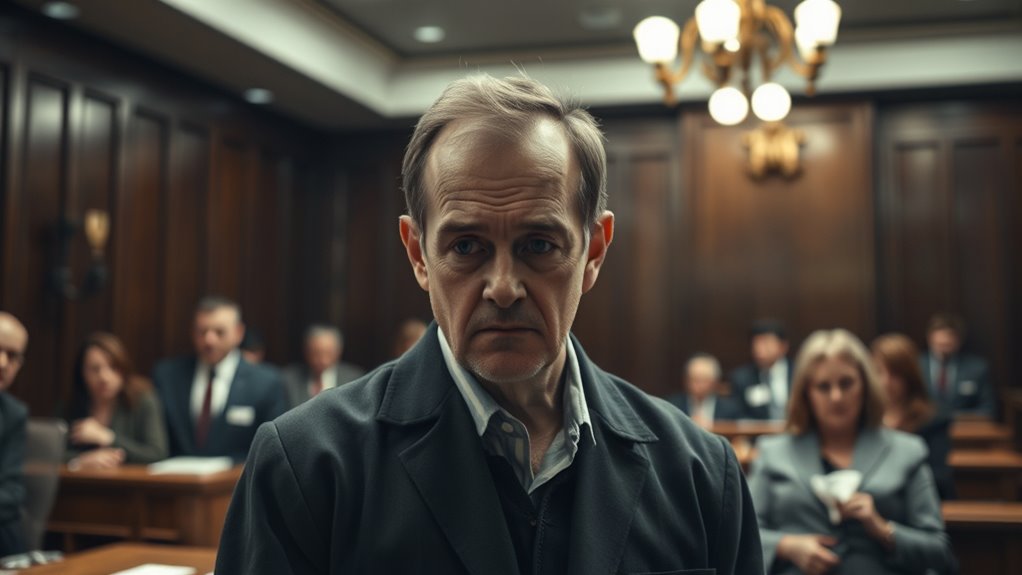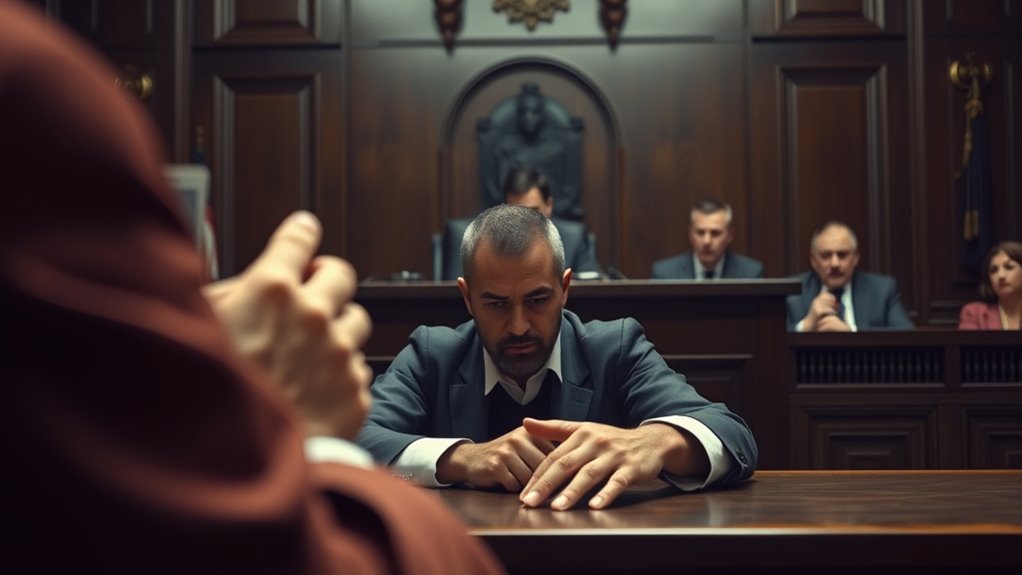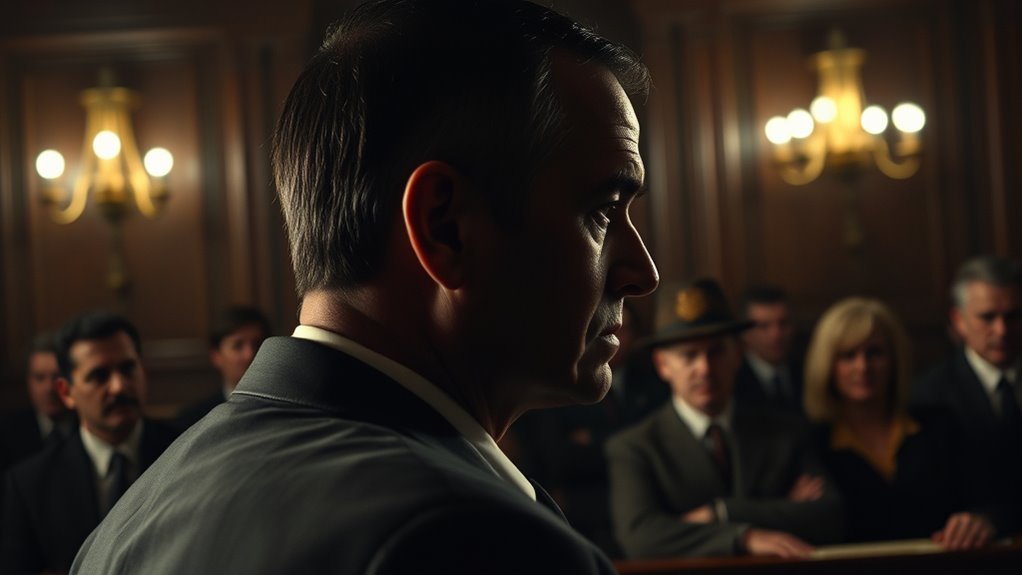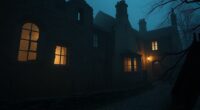The 1981 “Devil Made Me Do It” trial involving Arne Johnson is a groundbreaking case where a murderer claimed demonic possession as a legal defense. The evidence highlighted violent crime scenes, erratic behavior, and supernatural claims rooted in local folklore. The case challenged traditional justice by questioning accountability under supernatural influence, sparking debates about religion, mental health, and law. If you want to explore how the courtroom navigated these beliefs and the trial’s lasting impact, there’s more to uncover.
Key Takeaways
- Arne Johnson’s 1981 trial involved claiming demonic possession as a defense for his murder of landlord Alan Bono.
- The case sparked widespread debate about the legitimacy of demonic influence in criminal responsibility.
- Key witnesses testified about Johnson’s erratic behavior and alleged supernatural possession during the crime.
- The trial challenged legal boundaries by considering demonic possession as a mitigating factor.
- The case gained cultural significance, inspiring media, documentaries, and ongoing discussions about supernatural influence and justice.
The Background of the Case and Key Personalities

The Devil Made Me Do It trial centers around a chilling murder case that captured public attention due to its unusual defense strategy. You learn that Arne Johnson, the defendant, claimed demonic possession as a legal defense, sparking debates over its legal implications. The case involved key personalities, including Johnson, his victim, and the defendant’s family, whose testimonies shaped the trial’s trajectory. This case’s cultural impact was significant, challenging societal beliefs about accountability and the influence of supernatural forces. As you follow the story, you see how the defense’s reliance on demonic possession pushed boundaries in the legal system, prompting discussions about mental health, religious beliefs, and justice. The case’s notoriety endures, reflecting its profound influence on law and culture alike. Additionally, the case’s unique legal defense sparked widespread conversations about the intersection of spirituality and justice.
The Allegations and Crime Scene Details

You need to understand what happened at the crime scene and what led to the murder. The details of the incident reveal the motive and the evidence collected. This information is vital to grasping why authorities believe the accused is responsible. A key aspect of the investigation involved analyzing the scene for physical evidence that could link the suspect to the crime, highlighting the importance of evidence collection in solving such cases. Additionally, understanding the mechanics of arcade machines, like Galaga, can shed light on how certain gaming environments might be used in forensic analysis or recreations. Moreover, knowledge of legal procedures, such as the divorce process, can provide context for understanding the legal frameworks surrounding criminal cases. The ongoing development of AI security measures emphasizes the importance of safeguarding evidence and maintaining integrity in digital investigations. Incorporating meditation techniques at various stages of investigation can help maintain focus and clarity during complex case analysis.
Murder Details and Motive
What exactly happened on the night of the murder, and what drove Arne Johnson to commit such a crime? Witnesses say he was acting erratically, and he claimed demonic possession influenced his actions. Johnson stabbed his landlord, Alan Bono, multiple times during a confrontation. His defense argued that Johnson was not responsible due to legal insanity, asserting that a demonic force possessed him at the time. The crime scene revealed a violent struggle, with blood everywhere. Johnson’s claims of demonic possession became central to his defense, suggesting he wasn’t fully in control. The question remains whether his mental state, exacerbated by alleged supernatural influence, justified the killing or if it was a cold-blooded murder. The case ignited debates about demonic influence and mental health in the justice system. Additionally, the case drew attention to demonic influence as a legal and psychological consideration. This incident also highlighted the importance of understanding mental health in criminal cases involving alleged supernatural elements. Moreover, the case underscored the significance of psychological evaluations in assessing defendants with claimed supernatural experiences.
Crime Scene Evidence
On the night of the murder, the crime scene was a chaotic and gruesome tableau, with blood splattered across the apartment and evidence of a brutal struggle. Forensic analysis revealed bloody fingerprints, footprints, and weapon fibers, all crucial in reconstructing the event. Investigators carefully collected and preserved the evidence to ensure its integrity for presentation in court. The evidence presentation highlighted the violent nature of the attack, with blood spatter patterns indicating a close-range struggle. The forensic team’s detailed examination helped link Arne Johnson to the scene, strengthening the prosecution’s case. Every piece of evidence was meticulously documented, emphasizing its significance in establishing the timeline and motive behind the crime. This thorough forensic work played a vital role in shaping the trial’s outcome.
The Defense’s Unique Argument: Possession as a Legal Defense

The defense in the Devil Made Me Do It trial presents a compelling argument: that the defendant’s alleged actions resulted from possession, which they claim negates criminal responsibility. Their legal strategy hinges on the idea of demonic possession, asserting that supernatural forces influenced Arne Johnson’s behavior at the time of the crime. By framing possession as a legitimate defense, they challenge traditional notions of accountability, suggesting that external, uncontrollable forces override free will. This approach aims to persuade the court that Johnson’s actions weren’t entirely his own, shifting the focus from intent to supernatural influence. Additionally, this case has contributed to discussions about supernatural influences in legal contexts, raising questions about the boundaries of legal responsibility. The argument also draws on longstanding cultural beliefs about demonic possession affecting human behavior, which can influence legal perceptions and societal attitudes. The concept of legal responsibility becomes complex when supernatural explanations are introduced, prompting ongoing debate in both legal and cultural spheres. Recognizing the historical prevalence of superstitions in various societies adds another layer to understanding how such defenses are perceived and accepted. Moreover, some experts argue that the psychological impact of claims of possession can influence jury decisions and legal outcomes.
The Role of Supernatural Beliefs and Local Folklore

You might notice how local folklore deeply shapes community beliefs about good and evil. These supernatural stories often influence jurors’ perceptions of guilt or innocence, especially in cases like this. Understanding these cultural influences helps explain why such beliefs can sway legal judgments. Additionally, the spiritual beliefs of a community can significantly impact how justice is perceived and administered. The influence of home decor themes, such as symbols and motifs, can also reflect and reinforce local folklore and supernatural narratives.
Cultural Significance of Folklore
Supernatural beliefs and local folklore play an essential role in shaping cultural identity and moral frameworks within communities. Folk narratives serve as storytelling vessels, passing down lessons, values, and warnings across generations. These stories often reflect a community’s understanding of good and evil, right and wrong, through myth influence. They help define social boundaries and reinforce shared beliefs, creating a sense of unity and continuity. Folklore also preserves cultural heritage, allowing communities to connect with their history and traditions. When people recount tales of spirits, demons, or divine beings, they reinforce collective identity and moral codes. By understanding these stories, you gain insight into how societies interpret the supernatural and embed those beliefs into everyday life, shaping perceptions and behaviors over time.
Supernatural Beliefs Influence Jurors
How do deeply rooted supernatural beliefs shape the perspectives of jurors in criminal trials? When jurors believe in demonic possession or spiritual influence, they might interpret a defendant’s actions through a supernatural lens. Such beliefs can lead jurors to see a crime as the result of evil forces rather than personal responsibility. In cases like the “Devil Made Me Do It,” these ideas influence verdicts, as jurors are more inclined to accept claims of demonic influence or spiritual possession as mitigating factors. Local folklore and cultural narratives about spirits, demons, and spiritual influence deeply embed these concepts in community consciousness. This can sway jurors’ opinions, making them more receptive to supernatural explanations and affecting their judgments about guilt or innocence.
The Courtroom Proceedings and Public Reactions

During the courtroom proceedings of the “Devil Made Me Do It” trial, tensions ran high as attorneys presented contrasting evidence, and witnesses testified about the defendant’s alleged demonic influence. The legal strategies focused on whether demonic possession could be used as a valid defense, sparking heated debates among the lawyers. Media coverage intensified the public’s interest, with headlines emphasizing the supernatural aspects of the case. Spectators watched closely as the judge and jury considered whether this supernatural claim could hold weight in court. The trial’s sensational nature drew widespread attention, with some viewing it as a genuine legal challenge and others dismissing it as sensationalism. Public reactions ranged from disbelief to strong support, reflecting the case’s profound cultural impact beyond the courtroom.
The Trial’s Impact on Legal and Cultural Perspectives

The “Devil Made Me Do It” trial has considerably influenced both legal practices and cultural attitudes toward the supernatural. It challenged traditional legal implications by raising questions about insanity defenses rooted in supernatural beliefs. Courts had to contemplate whether claims of demonic possession could justify criminal behavior, prompting debates about the boundaries of legal responsibility. Culturally, the case reinforced narratives that link evil spirits with real-world consequences, shaping public perceptions of the supernatural. It fueled fears and fascination, influencing media coverage and popular culture. The trial pushed society to confront the idea that supernatural forces could impact human actions, prompting ongoing discussions about how belief systems intersect with justice and morality. Overall, it left a lasting mark on how we interpret crime and the supernatural.
Legacy and Ongoing Fascination With the Case

The “Devil Made Me Do It” trial has left a profound imprint that continues to shape public discourse and popular culture. Its legacy persists through ongoing fascination with supernatural influence on human behavior and the legal implications it raises. The case challenged societal perceptions of accountability, prompting debates about whether supernatural forces can mitigate responsibility. Pop culture references, documentaries, and books keep the story alive, fueling curiosity about the case’s supernatural elements. Legal systems still grapple with questions it raised about the influence of the supernatural in criminal defense. This case’s enduring fascination underscores how society struggles to reconcile traditional legal standards with beliefs in supernatural forces, ensuring the story remains relevant and provocative decades later.
Frequently Asked Questions
Did Arne Johnson Actually Believe He Was Possessed During the Crime?
You might wonder if Arne Johnson truly believed he was possessed during the crime. His defense invoked the exorcism controversy, suggesting demonic influence, but legal skepticism questioned whether he genuinely believed in possession or used it as a defense strategy. While Johnson claimed possession, skeptics argue he may have manipulated the situation to justify his actions. Ultimately, his true belief remains uncertain, blending the line between faith and legal doubt.
How Did the Court Verify Claims of Demonic Possession as a Defense?
Did you know that only 12 cases in U.S. history have used demonic possession as a legal defense? Courts rarely accept it, relying heavily on legal precedents and forensic evidence. In Johnson’s case, experts testified about his mental state, but the court required tangible proof, not just supernatural claims. This strict standard means claims of demonic possession face significant scrutiny, making such defenses extremely difficult to validate legally.
Were There Any Expert Witnesses Supporting the Supernatural Aspects of the Case?
You might wonder if expert witnesses backed the supernatural claims in this case. While some spiritual testimonies and exorcism rituals were presented, the court primarily relied on religious and psychological experts rather than scientific evidence. The spiritual testimonies aimed to support the demonic possession defense, but their credibility was debated. Overall, the case highlighted the tension between supernatural beliefs and legal standards, making expert support complex and controversial.
What Was the Public’s Reaction to the “Devil Made Me Do It” Defense?
Ever wonder how people react when supernatural defenses hit the courtroom? You’re likely to see a mix of public skepticism and media sensationalism, fueling controversy. Many doubt the devil’s influence, dismissing it as a desperate legal ploy. The media amplifies these doubts, turning the case into a spectacle. So, do you think the public’s reaction reflects genuine belief or just curiosity stirred by sensational headlines?
Has This Case Influenced Subsequent Legal Rulings Involving Supernatural Claims?
You might think this case set a legal precedent by acknowledging supernatural influence, but it didn’t considerably change how courts handle such claims. While it’s remembered for its sensational nature, most legal rulings still require concrete evidence over supernatural explanations. However, it sparked discussions about the limits of supernatural influence in courtrooms, making it a notable reference point, even if it didn’t fundamentally alter legal standards regarding the supernatural.
Conclusion
You might find it surprising that, even today, over 60% of Americans believe in some form of supernatural influence. The Arne Johnson case forces you to question whether the legal system can truly accommodate beliefs in possession. This trial’s enduring fascination shows how a single case can blur the lines between law, folklore, and morality, leaving you pondering whether justice always aligns with truth or if some stories are too extraordinary to ignore.









